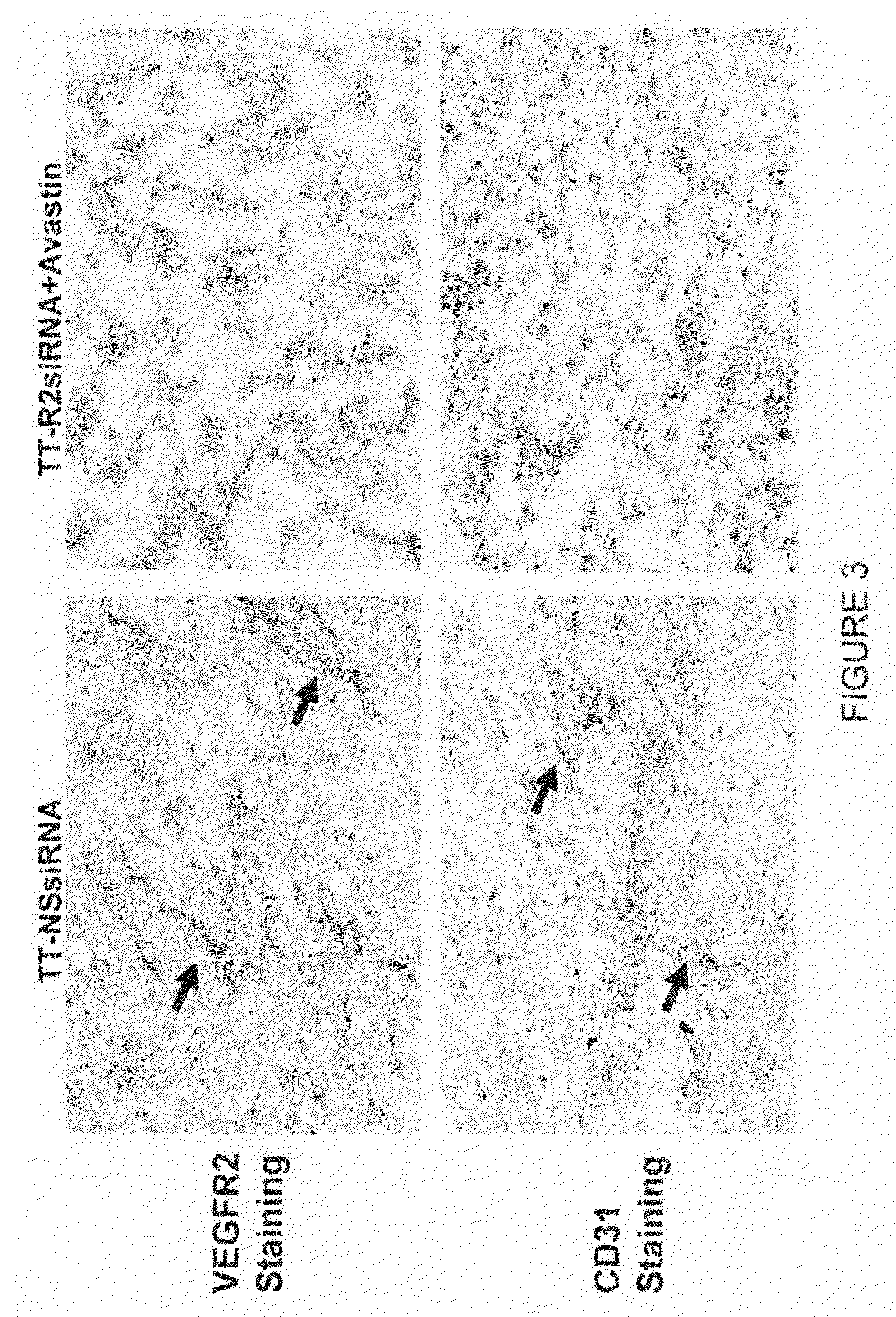Composition and methods of RNAi therapeutics for treatment of cancer and other neovascularization diseases
a technology of neovascularization disease and rnai, which is applied in the field of composition and methods, can solve the problems of ineffective agents for many patients, insufficient benefits for most patients, and difficult observation of rnai effects in adult animal models
- Summary
- Abstract
- Description
- Claims
- Application Information
AI Technical Summary
Benefits of technology
Problems solved by technology
Method used
Image
Examples
example 1
Tumor Growth Inhibition with Combination Use of siRNA Duplexes Targeting VEGFR2 and Bevacizumab (Avastin) Against VEGF
Material and Methods.
[0136]Reagents: Avastin, monoclonal antibody against VEGF (25 mg / ml, Genetech); siRNA against mouse VEGFR2, sequence ((a) AAGCTCAGCACACAGAAAGAC (SEQ ID NO: 247); (b) AATGCGGCGGTGGTGACAGTA) (SEQ ID NO: 248); siRNA against luciferase (Qiagen); Avertin made of 1.5 gram 2,2,2,Tribromoethanol and 1.5 ml t-amyl alcohol (Cat# T4840-2, Cat# 24048-6, Aldrich) in 100 ml distill water, St. Louis, Mo.]. Mice: athymus female nude mice, 5 to 6 weeks old, were purchased from TACONIC and housed conventionally. All investigations followed guidelines of the Committee on the Care of Laboratory Animals Resources, Commission of Life Sciences, National Research Council. The animal facility of Biomedical Research Institute in Rockville Md. is fully accredited by the American Association of Laboratory Animal Care. Cells: Colon carcinoma cell line, DLD-1 (CCL-221, ATCC) ...
example 2
siRNA-Mediated VEGF Silencing in vitro and in vivo
[0145]Human VEGF 165 specific siRNA was transfected into the MCF-7 / VEGF 165 cell (hVEGF over-expression) by Lipofectamine resulting in knockdown of hVEGF mRNA in the cell (FIG. 2 upper panel). Using an electroporation procedure, MCF-7 / VEGF 165 cells were transfected by hVEGF 165 specific siRNA, resulting in down regulation of hVEGF expression as determined with an ELISA analysis.
[0146]When the hVEGF 165 specific siRNA were delivered through intratumoral administration repeatedly, the growth of MCF-7 / VEGF165 cell induced xenograft tumors were significantly inhibited. This inhibition was further validated when the tumor tissues were collected for testing hVEGF mRNA expression which resulted in significant down regulation based on RT-PCR analysis. Using the same hVEGF165 specific siRNA, we are also able to demonstrate tumor growth inhibition with head and neck squamous cell carcinoma (HNSCC, 1483 cell) xenograft model, through 5 repeate...
example 3
25 Basepair Blunted Double-Stranded siRNA is More Potent than Regular 19 Basepair siRNA with 3′-Overhangs in Silencing Target Gene Expression
[0147]In one of in vitro siRNA transfection studies, the MCF / 165 breast cancer cells overexpressing human VEGF (hVEGF) were transfected with either 25 basepair blunted double-stranded siRNA (hVEGF-25-siRNA-a, hVEGF-25-siRNA-b, hVEGF-25-siRNA-c, Luc-25-siRNA) or 19 basepair siRNA with 3′ overhangs (hVEGF-siRNA-a, GFP-siRNA-a) using an electroporation mediated transfection method. 4×106 MCF7 / 165 cells were resuspended in 200 μl of siPORT siRNA Electroporation Buffer (Ambion) mixed with 5 μg siRNA and then subjected to electroporation treatment using an Electro Square Porator ECM830 (BTX, Fisher Scientific). The parameters for the electroporation are: voltage 500 v; duration of pulse 60 μs; pulse number 2; pulse interval 1 second. The transfected cells were seeded to 24-well plate at a density of 5×104 cell / well and cultured at 37° C. incubator wi...
PUM
| Property | Measurement | Unit |
|---|---|---|
| Fraction | aaaaa | aaaaa |
| Pharmaceutically acceptable | aaaaa | aaaaa |
| Hydrophilicity | aaaaa | aaaaa |
Abstract
Description
Claims
Application Information
 Login to View More
Login to View More - R&D
- Intellectual Property
- Life Sciences
- Materials
- Tech Scout
- Unparalleled Data Quality
- Higher Quality Content
- 60% Fewer Hallucinations
Browse by: Latest US Patents, China's latest patents, Technical Efficacy Thesaurus, Application Domain, Technology Topic, Popular Technical Reports.
© 2025 PatSnap. All rights reserved.Legal|Privacy policy|Modern Slavery Act Transparency Statement|Sitemap|About US| Contact US: help@patsnap.com



